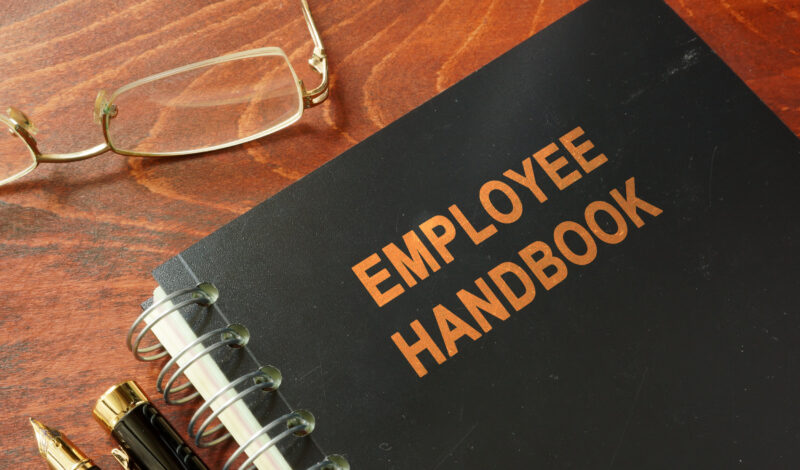The COVID-19 pandemic has changed the way businesses operate in so many ways. Some businesses have had to lay off some of their best employees, while others have had to permanently shut their doors. Even fortunate businesses have faced challenges, and one of those is making updates to their employee handbook.
An employee handbook serves as a great help to not only employees, but to employers, as well. Within your handbook you can include policies, guidelines, and procedures that will protect you and help your business operate, even in the most challenging times. If you are in the process of updating your employee handbook, below are some key considerations you may want to include.
The Company’s Values and Culture
It has always been important for employers to protect their employee’s health and safety, and the pandemic has only highlighted this need. An employee handbook is a great tool that can emphasize your commitment to prioritizing the well-being of your staff members by stating the actionable steps you are taking for their protection.
For example, if you have instituted new policies that create a feedback system for employees, include this in the handbook so employees know how to raise their concerns. This simple step will tell your employees that they are being heard, and that you are doing everything you can to help them during this unprecedented time.
Anti-Discrimination Policies
Your employee handbook should already clearly state your anti-discrimination policies, but now is a great time to reinforce them. Always ensure that your handbook includes statements that showcase your commitment to hiring individuals based on their experience and competency, without any consideration given to a person’s race, religion, color, or national origin.
Now is also a great time to clearly state how you will provide reasonable accommodations according to the Americans with Disabilities Act. In regards to COVID-19 specifically, you should also include the policies your company will implement for individuals that are considered more at risk for contracting the COVID-19 virus.
In addition to including statements against discrimination as outlined by Title VII of the Civil Rights Act, you should also include statements that prohibit employees from discriminating against each other in the event that one staff member contracts the virus. Make it clear that discrimination against these employees, or anyone that takes sick leave for any reason, is unacceptable.
Guidelines for Remote Work
Today, more people are working from home than perhaps ever before, as the CDC has provided guidance for remote work whenever possible. While including attendance policies in an employee handbook is always an important consideration, you may have to make additions specifically relating to remote work. To help you outline what is required of your employees who are working remotely, it is important to include within the handbook policies that provide guidance about:
-
Guidance for remote meetings
-
Documents that are required
-
Best communication practices
-
How employees should tell team members they are available
-
Security guidelines for protecting confidential information
-
Procedures for installation of necessary software
-
Expenses that will be reimbursed for work-related costs incurred by employees
Additionally, many parents working from home are also juggling child care at the same time. If you are providing additional support for these individuals, make sure to include them within the handbook and avoid gender-specific language.
Maximum Capacity Rules
Certain counties in California have placed restrictions on the number of people who can meet and gather in one space. It is crucial that you understand these laws to avoid fines and more importantly, the spread of the virus. If your employees must work within your workspace, understand whether or not you have to limit the capacity. Also keep in mind how this affects your attendance policies, and make any changes to those, as well.
Policies Related to Travel
Many people have to travel for their jobs, but this is one of the riskiest activities a person could engage in during the pandemic. Use your employee handbook to outline how traveling to other areas can be replaced by video conferencing and other methods to reduce the risk. If travel is an essential part of your business, ensure the following provisions are included in the handbook:
-
Travel is restricted to areas the local, state, and federal government have deemed safe
-
The administration will always refer to CDC’s travel notices prior to arranging a trip
-
Employees should still only meet outside with others, when possible
-
Personal protective equipment (PPE) will be provided to all employees that are required to travel
-
Whether certain employees will require a 14-day period of quarantine after travel
Also include within the handbook any specific steps an employee should take if they return from traveling and develop symptoms of COVID-19.
Leave Policies
Perhaps the most important aspect of your employee handbook to update are leave policies. It is crucial that you include policies within the handbook that prohibit employees from coming into work when they are showing symptoms of COVID-19, as that is one of the best ways to prevent the spread and keep your business and employees healthy. California has outlined specific benefits for employees that are quarantined, in isolation, or cannot work because they are carrying for someone that has contracted COVID-19, such as a child. It is essential that you understand these laws, how much employees are entitled to, and that you include this information within the employee handbook.
Call a California Business Lawyer for Help
Employee handbooks always have the potential to become complicated, but that has never been truer than in the midst of this pandemic. If you are making updates to your employee handbook, our Santa Monica business lawyer at Klein Law can help. We know the most important aspects to include in your handbook during COVID-19 and will ensure they are added clearly and in a way your employees can understand. Call us today at (310) 295-2261 to schedule a consultation and to learn more about how we can help.






